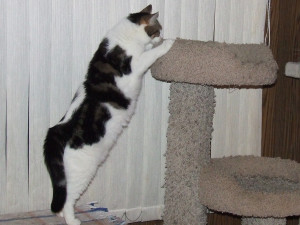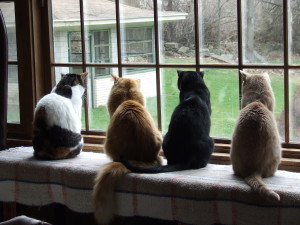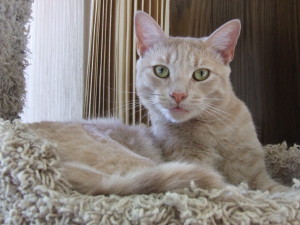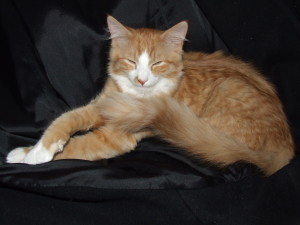Written by Tracy Dion for Raw Instincts Magazine November 2012 and last updated January 2013.
Around the Holidays, we think of the gifts and blessings in our lives with gratitude. One of the most precious gifts many of us share is the affection of a cat (or two or three!).
Unfortunately, feline life expectancy has been shrinking for over a decade. Obesity is now at epidemic levels for cats (and dogs), and many other preventable diseases are on the rise. The Banfield 2012 Pet Health Report five-year statistics show dramatic increases in several feline diseases, including a 15% climb in kidney disease, a 16% growth in diabetes mellitus, a significant 67% rise in arthritic cases, and an astonishing 90% leap in obesity.
 All of these diseases have links to diet and the first three are also linked to the fourth. It’s no surprise, then, that feline obesity has become a huge concern to veterinarians and cat owners alike.
All of these diseases have links to diet and the first three are also linked to the fourth. It’s no surprise, then, that feline obesity has become a huge concern to veterinarians and cat owners alike.
Why are so many cats getting fat?
There are several factors that impact a cat’s body condition, including age, sexual status (intact or not), activity level, and metabolism, but the single most important – and overlooked – element in maintaining the domestic cat’s weight is diet composition.
Although raw feeding is becoming increasingly more accepted, over 98% of today’s housecats are still fed standard commercial diets, primarily kibble, and quite often on a free-feeding schedule. Kibble is a profoundly unhealthy diet for an obligate carnivore that evolved to have its water needs met through its food, but even more detrimental to feline health is the large carbohydrate content of many canned and the vast majority of kibble products (which require those ingredients to hold their form).
Like all obligate carnivores, cats have a digestive physiology that is uniquely and beautifully designed to harness the nutrients and calories from other animals to meet their nutritional and basil energy requirements. They have no dietary need for carbohydrates and, in fact, lack several of the metabolic pathways that would allow them to efficiently digest and utilize carbs. Furthermore, digested carbs are converted into glucose (or sugar) (Becker, Causes of Pet Diabetes) and – since cats are metabolically adapted for preferential use of animal protein and fat as energy sources (Zoran, Carnivore Connection) – typically stored as body fat. A high-carb diet provides a large number of calories that are destined to do no more than increase feline girth (and litter box usage!).

Conversely, cats readily and efficiently convert animal protein and fat into the energy they need to grow, maintain and repair every system in their bodies. Indeed, cats are so extraordinarily well-designed to process animal tissues that few of those calories are ever converted to body fat; you will rarely see an obese raw-fed cat.
In addition, animal protein – not food quantity – is the satiety trigger for cats. Until they ingest an adequate amount of recognizable animal protein, they will continue to feel hungry and, given the opportunity, will consume far more food than would otherwise be necessary. Compounding this issue is the negative effect a high carb diet has upon protein absorption, requiring more food – and the concurrent ingestion of more carb calories – to satisfy the cats’ hunger.
It’s easy to see how today’s predominately high carb, low protein cat foods almost invariably lead to feline obesity, and the pervasive practice of free-feeding just exacerbates the problem.
Why not just restrict caloric intake?
Restricting caloric intake without regard to diet composition is often effective in reducing weight in people, dogs and sometimes even cats, but it is ineffective as a long-term feline weight management solution for our domestic cat population and can actually be detrimental to their health.
First, as already described, a calorie is not just a calorie to an obligate carnivore, and cats can consume more protein calories than carb calories without gaining weight (Winn study). In fact, if a cat is transitioned to a higher protein, lower carb diet, it will often begin losing weight even when the new diet contains a higher number of calories overall. Not only will the meat based calories provide the cat with necessary energy – while the calories from the carbs head primarily to fat storage – but cats on a high protein diet are more satisfied, energetic, and less anxious. Their higher levels of energy and wellbeing will also result in more play and a stronger overall physiology and immune system.
 Of equal importance, cats have hepatic enzyme systems that are constantly active, requiring the catabolization of a fixed amount of dietary protein for energy no matter how much energy may also be available via carbs or fats (Dr. Peterson, Can Increasing…).
Of equal importance, cats have hepatic enzyme systems that are constantly active, requiring the catabolization of a fixed amount of dietary protein for energy no matter how much energy may also be available via carbs or fats (Dr. Peterson, Can Increasing…).
Let me emphasize this point – although cats can use some carbs for metabolic energy, their ability to swap protein utilization for carbs is so severely limited (Zoran, Carnivore Connection), they will cannibalize the protein in their own muscles to meet their basic daily needs if their diet does not contain enough, completely irrespective of how many carbs (or fat) they may also be eating.
And this leads to the second reason simple caloric restriction is ineffective and inappropriate for housecats.
Most calorie-restrictive commercial products are high in fiber (a form of carbs) and do not contain enough protein to meet basic needs and preserve lean body mass. This decrease in muscle mass is an unhealthy weight loss state (especially worrying for senior cats) that will actually lower metabolism, make additional weight loss more difficult and increase the likelihood of a subsequent regain of body weight in fat.
In addition, fiber – not a naturally-occurring part of the cat’s diet – blocks absorption of crucial nutrients into the small intestine, preventing the uptake of trace minerals, vitamins and antioxidants. Chronic nutrient deficiencies can lead to a host of diseases, not to mention a constantly hungry feline.
These diets can lead to a cat that is concurrently overweight and nutritionally deficient. And disinclined to do much beyond eat and sleep (Becker, Fat Cats…)
So what’s the recommended weight reduction solution?
Unfortunately, the pet food industry is not required to disclose the percentage of real meat in their products. Clearly, then, using recommended feeding allowances or calorie calculators to determine how much to feed a cat, especially one that needs to lose weight, is fairly futile.
The most optimal diet composition is roughly 52% protein, 46% fat and 2% carbs on a dry matter basis (Plantinga, Estimation of…). Carb content is another bit of vital information most pet food products do not publish, but you can get a rough estimate of a product’s carb content by adding the protein, fat, fiber, moisture and ash levels, subtracting that amount from 100, and dividing the result by the percentage of dry matter in the product.
For example, a product analysis that lists 50% protein, 22% fat, 2.80% fiber, 10% moisture, and .5% ash = 14.7 (100 – 85.3 (50 protein + 22 fat + 2.8 fiber + 10 moisture + .5 ash = 85.3) divided by .9 (100 – 10 moisture = 90% or .9) = 16.33% carbs.
Your healthiest diet option, whether your kitty needs to lose weight or not, is a canned or raw diet that contains no or minimal amounts of fruits, grains or vegetables (less than 10% is good, less than 5% is better, none at all is best). Start by feeding about 4% of your cat’s weight in ounces of canned food and 3% in raw per day, and then adjust the amount you feed based upon your cat’s ongoing body condition.
Moving from free-feeding to offering three or four scheduled meals a day is also crucial to weight loss. Such a schedule more closely matches the cats’ natural feeding pattern and has benefits that exceed weight management and include facilitating a digestive system that is healthy, strong, and working at peak efficiency.
 Finally, increasing your cat’s activity level will burn calories and increase lean muscle mass, effectively speeding up her metabolism. Daily interactive play sessions using wands, laser lights and other toys should be routine. Schedule these games for the same time every day and aim for dusk and dawn when the cats’ natural hunting instincts are in high gear. Drag, dart, and hide the ‘prey’ to fully engage the cats’ hunting behaviors and end each session by tossing the cat a healthy treat – such as freeze-dried meat – or a catnip toy to generate the satisfaction that accompanies a successful hunt.
Finally, increasing your cat’s activity level will burn calories and increase lean muscle mass, effectively speeding up her metabolism. Daily interactive play sessions using wands, laser lights and other toys should be routine. Schedule these games for the same time every day and aim for dusk and dawn when the cats’ natural hunting instincts are in high gear. Drag, dart, and hide the ‘prey’ to fully engage the cats’ hunting behaviors and end each session by tossing the cat a healthy treat – such as freeze-dried meat – or a catnip toy to generate the satisfaction that accompanies a successful hunt.
In summary, routinely engaging your cat in play and offering her a fresh, raw diet that closely matches the nutrient composition she evolved to eat, on a schedule that more closely mimics her natural eating behavior, will almost certainly result in a healthier, more svelte and energetic version of her current self. Reducing or eliminating carbs is part of that equation, counting calories is not!
If you enjoyed this article or found it informative, please “Like” it, “Tweet” it, or share it using any of the buttons below. And don’t forget to check out our FB page, join the discussions in our awesome FB group and follow us on Twitter!
Created 01/01/13; Updated 08/11/14

